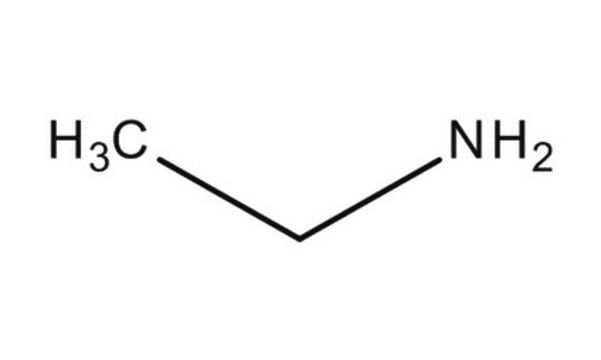Products may be shipped at a different temperature than the recommended long-term storage temperature. If the product quality is sensitive to short-term exposure to conditions other than the recommended long-term storage, it will be shipped on wet or dry-ice. If the product quality is NOT affected by short-term exposure to conditions other than the recommended long-term storage, it will be shipped at ambient temperature. As shipping routes are configured for minimum transit times, shipping at ambient temperature helps control shipping costs for our customers. For more information, please refer to the Storage and Transport Conditions document: https://www.sigmaaldrich.com/deepweb/assets/sigmaaldrich/marketing/global/documents/316/622/storage-transport-conditions-mk.pdf
724033
Ethylamine
99.0%
Sinónimos:
Aminoethane, Monoethylamine
About This Item
Productos recomendados
densidad de vapor
1.56 (15 °C, vs air)
Nivel de calidad
presión de vapor
874 mmHg ( 20 °C)
Ensayo
99.0%
Formulario
gas
temp. de autoignición
721 °F
lim. expl.
14 %
3.5-14 %
bp
16.6 °C (lit.)
mp
-81 °C (lit.)
densidad
0.680 g/mL at 20 °C (lit.)
0.689 g/mL at 25 °C (lit.)
grupo funcional
amine
cadena SMILES
CCN
InChI
1S/C2H7N/c1-2-3/h2-3H2,1H3
Clave InChI
QUSNBJAOOMFDIB-UHFFFAOYSA-N
¿Está buscando productos similares? Visita Guía de comparación de productos
Envase
Compatible with the following:
Información legal
Opcional
espiga
regulador
también adquirido normalmente con este producto
Palabra de señalización
Danger
Frases de peligro
Consejos de prudencia
Clasificaciones de peligro
Acute Tox. 4 Inhalation - Eye Irrit. 2 - Flam. Gas 1 - Press. Gas Liquefied gas - STOT SE 3
Órganos de actuación
Respiratory system
Código de clase de almacenamiento
2A - Gases
Clase de riesgo para el agua (WGK)
WGK 1
Punto de inflamabilidad (°F)
-34.6 °F - closed cup
Punto de inflamabilidad (°C)
-37 °C - closed cup
Elija entre una de las versiones más recientes:
¿Ya tiene este producto?
Encuentre la documentación para los productos que ha comprado recientemente en la Biblioteca de documentos.
-
How is shipping temperature determined? And how is it related to the product storage temperature?
1 answer-
Helpful?
-
-
How can I determine the shelf life / expiration / retest date of this product?
1 answer-
If this product has an expiration or retest date, it will be shown on the Certificate of Analysis (COA, CofA). If there is no retest or expiration date listed on the product's COA, we do not have suitable stability data to determine a shelf life. For these products, the only date on the COA will be the release date; a retest, expiration, or use-by-date will not be displayed.
For all products, we recommend handling per defined conditions as printed in our product literature and website product descriptions. We recommend that products should be routinely inspected by customers to ensure they perform as expected.
For products without retest or expiration dates, our standard warranty of 1 year from the date of shipment is applicable.
For more information, please refer to the Product Dating Information document: https://www.sigmaaldrich.com/deepweb/assets/sigmaaldrich/marketing/global/documents/449/386/product-dating-information-mk.pdfHelpful?
-
-
What causes ethylamine to come out of its cylinder as a clear liquid, but then immediately turn dark blue in a receiving beaker?
1 answer-
According to the product manager, amines (NH3, NH2R) have the ability to solvate free electrons, resulting in an ink-like blue color. However, this typically occurs only in the presence of metals such as Li, K, Na, which provide the free electron. In the case of chemical synthesis applications, the color is not a significant concern as it does not affect the performance of such applications in general. Additionally, the majority of products are prone to color changes due to the very small traces of impurities present (ppm to ppb) or those that might form due to the reaction with oxygen/moisture over time.
Helpful?
-
Active Filters
Nuestro equipo de científicos tiene experiencia en todas las áreas de investigación: Ciencias de la vida, Ciencia de los materiales, Síntesis química, Cromatografía, Analítica y muchas otras.
Póngase en contacto con el Servicio técnico






